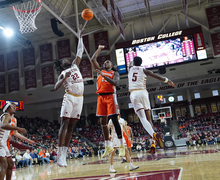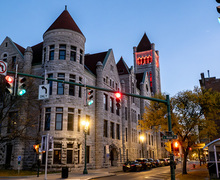Diploma Divide: College soccer faces pressure to change or lose out on top players
Tony Chao | Art Director
Collegiate soccer, along with the game in the rest of the country, has improved in the past 30-plus years. But if college soccer doesn’t reform now, Ian McIntyre and other coaches argue, it will lose out on more top talent.
The best 18-year-old soccer players in the world, in America, aren’t playing college soccer. There’s no reason for them to. They can practice, play and get paid to do so with professional teams around the country and globe, constantly perfecting their craft.
There’s another set of players, almost as good, who can get even better. But they go to college and don’t get the practice to fulfill their potential. It’s NCAA policy to limit players to 20 hours of practice per week in-season and eight out of season – though there are further limits on how much they can practice with their coaches.
Syracuse head coach Ian McIntyre is part of a coalition of top college coaches — including Maryland’s Sasho Cirovski, Indiana’s Todd Yeagley and supported by West Virginia athletic director Oliver Luck — pushing for the NCAA to change its regulations on Division I college soccer and allow teams to play a few more games in an extended fall-spring season.
“We are one of the more mobilized coaches groups out there,” McIntyre said. “This is something we’ve talked about for the last year or so.”
Collegiate soccer, along with the game in the rest of the country, has improved in the past 30-plus years. But if college soccer doesn’t reform now, McIntyre and other coaches argue, it will lose out on more top talent.
“We already are,” McIntyre said.
As Major League Soccer evolves, more and more professionalized club academy systems are scooping up players, allowing teams to sign local talent to Homegrown contracts — which don’t count against team salary caps. There are increasing and better opportunities. Without action from the NCAA, coaches say, there is a closing window in which college soccer can stay relevant.
McIntyre can offer a soccer prospect a number of games he probably wouldn’t get to play in competing for time at the professional level. But they come too quickly to help the player fully develop. McIntyre, or any college head coach, can’t work with his players for more than two hours per week in the offseason.
Outside of the season, their skills are stunted. In it, their academics are risked by near-constant travel and their bodies are ground along the brink of breaking down, reducing midweek practices to tactical walkthroughs. When McIntyre’s squad ended practice Monday, no one was sweating.
“Right now we’re managing players rather than training players,” McIntyre said.
Andrew Wenger was the No. 1 pick in the 2012 MLS SuperDraft after playing three seasons at Duke. Every summer during his Duke career he played in the Premier Development League, a division of the United Soccer Leagues in which most of the country’s best college players play.
Effectively, he extended his season. He remembers that each fall some of his Blue Devils teammates would return to Durham not in good enough shape to play a competitive game. They hadn’t all summer. They’d been working summer internships. And for some of them, it took two months — half the season — to get there.
“If everybody’s not rowing in the same direction — it’s the old adage, you’re working against yourself,” said Brendan Burke, Northeastern associate head coach and SU goalkeeper Alex Bono’s former coach at Reading United. “All it takes is a couple to not be focused on what they’re doing.”
It weakened the team, the training sessions and the better players in them. The very best college players, Wenger said, come out of school behind and tend to have narrower, lower-paying career paths with some even sliding out of MLS into the United Soccer League PRO division or the North American Soccer League.
On Aug. 28, Stanford sophomore midfielder Jordan Morris became the first college player called up to the U.S. men’s national team since 1999. Of the 18 other field players named to the roster for the U.S. friendly match against the Czech Republic on Sept. 3, only four had played any college soccer.
It showed.
“The main thing that I noticed is the speed of play is so high,” Morris said. “I think just as you keep moving up levels, that’s a huge difference is just — everyone is so technically gifted to get to where they are at that level.”
Without college soccer, Morris wouldn’t have been with the national team in Prague, Czech Republic. He said he wasn’t physically or technically developed enough coming out of high school and Eastside FC, a youth club in Washington. Morris didn’t even know if he wanted to play professional soccer then, he said.
But he thinks college soccer should change. An extended season, he said, would give more players more practice on their individual skills and team play, raising the level of external and internal competition.
“It’s kind of hard when you’ve got a whole year left to put all your focus into getting technically better,” Morris said.
For decades, college soccer was practically the only route to being a professional soccer player in America. Former U.S. national team midfielder and Reading United technical director Troy Snyder remembers the original North American Soccer League folding when he was playing at Penn State in the mid-1980s, leaving American soccer with no nationwide system of organized soccer more competitive than the NCAA.
And while college soccer today is surrounded and becoming overmatched by MLS teams, theirs and other U.S. Soccer Development Academy teams, it is better than it was then, Snyder said.
“I think college kids are training harder in the weight programs, just everything about it has gotten much more serious in all aspects of it,” Snyder said. “… I still disagree with the number of games. I think they should play more games.”
SU midfielder Stefanos Stamoulacatos just missed out on his youth club, Empire United, joining the U.S. Soccer Development Academy system. Empire didn’t align with the New England Revolution until his senior year of high school.
He’s trained with Greek professional clubs AEK Athens at age 17 and Olympiacos when he was 15. There, practicing was just a matter of doing one’s job, he said.
Stamoulacatos also wants an extended, more spread-out college season. He acknowledges that some schools, not wanting to invest in a two-season soccer team, might drop their programs as others create more professional training environments.
“Do whatever it is to make it more professional-like,” Stamoulacatos said. “I guess there would have to be sacrifices.”
Published on September 17, 2014 at 12:30 am
Contact Jacob: jmklinge@syr.edu | @Jacob_Klinger_





